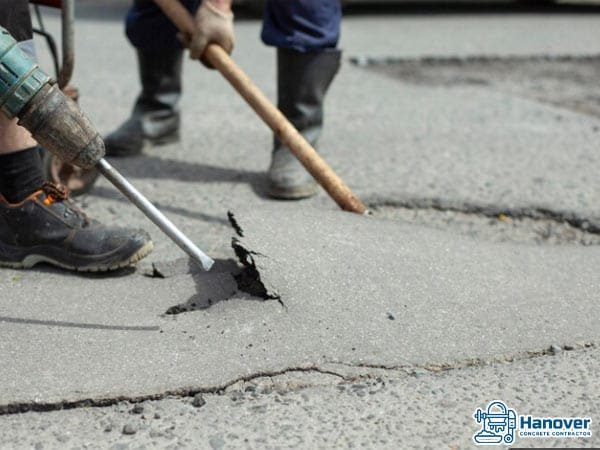Cracks in a concrete driveway can sneak up on you. I noticed a few in mine last year and didn’t think much of it—until they got worse. I didn’t want to spend a lot, so I looked for a way to fix them without hiring someone. If you’re in the same boat, this guide will walk you through how to repair cracks in a concrete driveway on a budget. It’s simple, affordable, and something you can do yourself.
Why Concrete Driveways Crack Over Time
Concrete looks strong—and it is—but it’s not perfect. I learned this the hard way. My driveway started to show small cracks after a few years, and I wanted to know why.
The truth is concrete moves. As the ground under it shifts, the concrete above it starts to stress. If the soil settles unevenly or has poor drainage, cracks can form. Another big reason is the weather. When it rains and freezes, water gets into the concrete, expands, and causes small splits. Over time, those little splits grow into more significant cracks.
Heavy vehicles can also pressure weak spots, and poor installation doesn’t help either. If the base isn’t packed well or the mix isn’t right, the surface won’t last. So even if your driveway looks solid, it’s still dealing with pressure, weather, and wear every day. That’s why cracks happen—and why fixing them early is so important.
Tools and Materials You’ll Need
I didn’t want to spend a lot when I fixed my driveway, so I looked for simple tools and low-cost materials. Most of what I used came from my local hardware store.
You’ll need a wire brush, broom, and bucket for cleaning. I also grabbed a putty knife and a caulking gun, which helped me apply the filler neatly. If you want a smoother finish, you can use a trowel, too.
For materials, I picked up concrete crack filler or patch compound. There are different types, but make sure it says it works for driveway cracks. If your crack is wide or deep, you may also need a backer rod—a foam piece that helps fill the space before sealing it.
You don’t need fancy tools. The goal is to clean the crack, fill it right, and seal it so water can’t get in. You can do the job and save money with the right supplies and care.
Step-by-Step Guide: How to Repair Cracks in a Concrete Driveway

Clean the Cracks Thoroughly
Before you do anything else, clean the cracks. I didn’t do this right first, and the filler didn’t stick well. So now, I will take my time to complete this step.
Start using a wire brush to scrub loose dirt, small stones, or old filler. Then, grab a broom or a shop vacuum and clear everything out. You want the crack to be as clean as possible. If there’s any grease or oil, use a cleaner and rinse it off with water. Let it dry completely before you move on. This step makes a big difference in how well the repair holds up.
Choose the Right Filler or Patch Material
Not all crack fillers are the same. I used to think one type worked for everything, but I was wrong. What you choose depends on the size and depth of the crack.
For thin hairline cracks, I go with a liquid crack filler. It flows easily and fills the small gaps. I use a thicker patch compound for wider cracks—anything more than a quarter inch. Sometimes, I press in a foam backer rod first so the filler doesn’t sink too deep or waste material.
Check the label to ensure it’s for driveways and can handle traffic and weather. I like using flexible products after they dry so they can move with the concrete. Picking the right material strengthens the repair and helps prevent the crack from returning.
Apply the Filler Properly
Once the crack is clean and dry, and you’ve picked the right filler, it’s time to apply it. I always cut the tip of the filler tube at an angle—it makes it easier to control the flow. If I’m using a caulking gun, I keep the pressure steady and move slowly along the crack.
I don’t try to fill it all in one go. I work in short sections, ensuring the filler gets deep into the crack. If the filler starts to bubble or sit on top, I pause and press it down gently with a putty knife. It’s better to fill slowly and evenly than to rush through it.
For deeper cracks, I apply the filler in layers. I let the first layer settle a bit before adding more. That way, the material bonds better and doesn’t sink in too much once it dries.
Smooth and Seal the Surface
After filling the crack, smoothing it out makes a big difference. I use a putty knife or trowel to level the surface to match the rest of the driveway. I wipe the edges gently to keep things neat.
Next, I give the filler time to dry. Most products need at least a few hours, but I always check the label. Once it’s dry, I seal it. A concrete sealer helps protect the repair from water, dirt, and weather. I roll it on or use a sprayer—whatever I have on hand.
This final step keeps moisture out and helps the repair last longer. It also gives the surface a nice finish that blends in better. Taking the extra time here really pays off in the long run.
DIY vs. Hiring a Professional: What to Consider
I’ve done minor crack repairs and hired a pro for more significant problems. If the cracks are thin and not too long, you can fix them with a few tools and a little time. It’s cheaper and feels good to do the job independently.
But some cracks go deeper. It might be more than surface damage if you see uneven slabs, large holes, or water pooling around the cracks. In those cases, I bring in a professional. They have the tools and experience to handle the deeper issues I can’t fix with a simple filler.
Tips to Save Money on Concrete Crack Repairs
I’ve learned a few tricks that keep repair costs low. First, I shop around. I check prices online and at local stores. Sometimes, I find the same product for less just by looking more complicated.
I also buy only what I need. Buying a big tub of filler is tempting, but if I fix a few cracks, a small tube works fine. I keep my tools clean so I can reuse them. That saves me from buying new ones every time.
Sometimes, I even split the costs with a neighbor. We both had cracks to fix, so we bought materials and shared what we didn’t use. Simple things like that go a long way when you’re on a budget.
How to Prevent Future Driveway Cracks
After I fixed my driveway, I didn’t want to deal with new cracks anytime soon. I started doing a few easy things to keep it in good shape.
First, I sealed it. A good sealer blocks water and helps the surface last longer. I reapply it every couple of years. Second, I keep it clean. I sweep away leaves and dirt so they don’t trap moisture. I use a snow shovel, not a metal blade, to avoid scratching the surface in winter.
I also make sure water drains away from the driveway. Water sitting near the edges can seep underneath and cause cracks. Fixing those little drainage problems helped me avoid big ones later.
Simple care makes a big difference. It keeps your repair work strong and your driveway looking good for years.
Conclusion
Fixing cracks in a concrete driveway doesn’t have to cost a lot. You can handle most repairs yourself with the right tools in a bit of time. Clean the crack, use the right filler, and seal it well. Take care of your driveway, and it’ll last much longer—without breaking your budget.
FAQs
1. Can I repair concrete driveway cracks myself?
Yes, you can. Small to medium cracks are easy to fix with basic tools and the right filler.
2. What is the best filler for driveway cracks?
It depends on the crack size. Use liquid filler for small cracks and patch compound for wider ones.
3. How long does a crack repair last?
If done right, a repair can last several years. Using a sealer helps it last even longer.
4. Is sealing the driveway necessary after a repair?
Yes. Sealing protects the surface from water, dirt, and weather damage.
5. When should I call a professional?
Call a pro if the cracks are deep, wide, or keep coming back. Also, get help if the surface is uneven.





